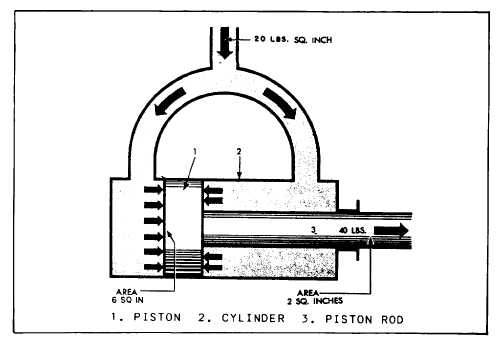DIFFERENTIAL AREAS.— Consider the
special situation shown in figure 2-12. Here, a
single piston (1) in a cylinder (2) has a piston rod
(3) attached to one of its sides. The piston rod
extends out of one end of the cylinder. Fluid under
pressure is admitted equally to both ends of the
cylinder. The opposed faces of the piston (1)
behave like two pistons acting against each other.
The area of one face is the full cross-sectional area
of the cylinder, say 6 square inches, while the area
of the other face is the area of the cylinder minus
the area of the piston rod, which is 2 square
inches. This leaves an effective area of 4 square
inches on the right face of the piston. The pressure
on both faces is the same, in this case, 20 psi.
Applying the rule just stated, the force pushing
the piston to the right is its area times the pressure,
or 120 pounds (20 x 6). Likewise, the force
pushing the piston to the left is its area times the
pressure, or 80 pounds (20 x 4). Therefore, there
is a net unbalanced force of 40 pounds acting to
the right, and the piston will move in that
direction. The net effect is the same as if the piston
and the cylinder had the same cross-sectional area
as the piston rod.
VOLUME AND DISTANCE FACTORS.—
You have learned that if a force is applied to a
system and the cross-sectional areas of the input
and output pistons are equal, as in figures 2-9 and
2-10, the force on the input piston will support
an equal resistant force on the output piston. The
pressure of the liquid at this point is equal to the
force applied to the input piston divided by the
piston’s area. Let us now look at what happens
when a force greater than the resistance is applied
to the input piston.
In the system illustrated in figure 2-9, assume
that the resistance force on the output piston is
100 psi. If a force slightly greater than 100 pounds
is applied to the input piston, the pressure in the
system will be slightly greater than 10 psi. This
increase in pressure will overcome the resistance
force on the output piston. Assume that the input
piston is forced downward 1 inch. The movement
displaces 10 cubic inches of fluid. The fluid must
go somewhere. Since the system is closed and the
fluid is practically incompressible, the fluid will
move to the right side of the system. Because the
output piston also has a cross-sectional area of
10 square inches, it will move 1 inch upward to
accommodate the 10 cubic inches of fluid. You
may generalize this by saying that if two pistons
in a closed system have equal cross-sectional areas
and one piston is pushed and moved, the other
piston will move the same distance, though in the
opposite direction. This is because a decrease in
volume in one part of the system is balanced by
one equal increase in volume in another part of
the system.
Apply this reasoning to the system in figure
2-11. If the input piston is pushed down a distance
Figure 2-12.—Differential areas on a piston.
2-8


